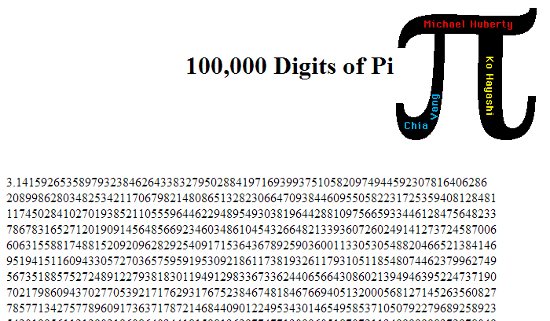


With the development of calculus in the 17th century by Isaac Newton and Gottfried Leibniz, the English mathematician and physicist published up to the fifteenth digit. Source: Wikimediaĭecimals began to flourish in the first millennium of our era at the hands of Chinese, Indian and Arab mathematicians, who undertook cumbersome calculations to reach the seventh or ninth digits of pi. Archimedes created an algorithm which allowed a better approximation. However, and although in classical Greece the letter π (“p”) was used in the notation of geometric calculations because it was the first letter of “periphery” or “perimeter”, it was not until the eighteenth century when its use began to be standardised it was Leonhard Euler who in 1736 established the definition of “ π ” as half the circumference of a circle whose radius is equal to one, or 3.14…. Archimedes also observed that this same number related the area of a circle to its radius. Interestingly, before the proposal from the State of Indiana, perhaps the last integer value of pi appears in the Bible: the First Book of Kings, written about the 6th century BC, speaks of a sea of molten metal with a circumference of 30 cubits and a diameter of 10 cubits, which would give a value of pi equal to three.Īround 250 BC, the Greek polymath Archimedes created an algorithm, based on the Pythagorean theorem, which allowed a better approximation by inscribing and circumscribing a circle with polygons he calculated its upper and lower limits, 3/7 and 310/71, which predicted an average value of 3.1418…. that yields a calculation of 256/81, around 3.1604. Another estimated value appears in the Rhind Papyrus, an Egyptian mathematical document from 1650 B.C. In ancient Babylon, a value of 3/8, or 3.125, was calculated by relating the length of a circumference to the perimeter of an inscribed hexagon, as deduced from a clay tablet dated around 1900 B.C. Credit: Paul James CowieĪlthough today we know pi ( π ) as the ratio between the length of a circumference and its diameter, the first historical approximations arose when analysing the relationship between polygons and circles. Fortunately, the text was never voted on in the Senate, enduring only as one of the more bizarre episodes in the history of the world’s most popular irrational number, a mathematical constant whose endless quest has captivated human beings for centuries. By introducing as a “new mathematical truth” a supposed method for squaring the circle -defining with compass and straightedge a square with the same area as a circle- invented by the physician and amateur mathematician Edward Goodwin, the law established de facto a value of 3.2 for the number pi. On February 5 or 6, 1897, the House of Representatives of the State of Indiana (USA) passed one of the most absurd laws in history by a vote of 67 to 0. dot () print ( "Inside of quarter-circle:" ) print ( inside ) print ( "Total amount of points:" ) print ( np ) print ( "Pi is approximately:" ) print (( inside / np ) * 4.0 ) turtle. sqrt ( x ** 2 + y ** 2 ) if d <= length : inside += 1 turtle. uniform ( 0, length ) #determine distance from center d = math. circle ( length, - 90 ) inside = 0 for i in range ( 0, np ): #get dot position x = random. pendown () #draw quarter of circle turtle. speed ( "fastest" ) length = 300 # radius of circle and length of the square in pixels #draw y axis turtle. isdigit (): print ( "Insert number of points:" ) np = input () np = int ( np ) turtle. Import random import math import turtle print ( "Insert number of points:" ) np = input () while not np. However, it is a method that is easy to imagine and visualize (at the cost of even slower performance). You will have to wait quite long to get the same amount of digits of π as, for example, the Nilakantha series. The program can't just use the area directly because calculating the area of the quarter-circle would require π, which this program is supposed to determine.So, because of:Ī q u a r t e r c i r c l e A s q u a r e = 1 4 π r 2 r 2 = 1 4 π With a lot of points, dividing the amount of points inside the quarter-circle by the amount of points inside the square will be like dividing the area of the quarter-circle by the area of the square.The program will generate random points inside the square, and then check whether they are also inside the circle. Imagine a square with any length, and inside it a quarter of a circle with a radius that is same as that length.


 0 kommentar(er)
0 kommentar(er)
